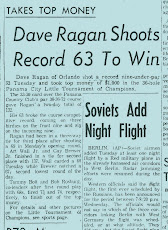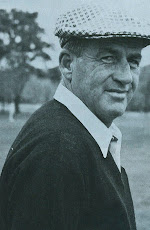The two men, A.I. Christo and Gardner "Pop" Dickinson, began kicking around the idea of staging a local golf tournament in which the sport's biggest names would be invited to play. Better yet, local amateurs would have an opportunity to play alongside the pros during the tournament.
The idea was not as outlandish as it might have seemed. After all, Christo, owner of a local discount store as well as the popular Seven Seas Restaurant, had plenty of connections with local merchants, and was certain the money could be raised. And Pop Dickinson's son, Gardner Dickinson Jr, was a well-known tour professional himself. Perhaps he could persuade some of his tour friends to come to Bay County for a few days of golf in the Florida sun.
It didn't take long for other friends and merchants to warm to the idea. Panama Country Club Pro Woody Lafoon offered services of the club. Car dealer Bill Cook promised free transportation for the visiting pros. The Holiday Lodge Motel at the foot of Hathaway Bridge offered free accomodations. Local merchants Mack Lewis, and Henry Vickery and others contributed considerable time and personal funds.
Interested parties came together February 15, 1962, over lunch at the Seven Seas. The group called themselves the Panama City Sports Association, and articles of incorporation were drawn up. "The corporation's objective," Pop later recalled, "was the advertising of Bay County through promotion of the event."
Pop even had a name: the Little Tournament of Champions. A $6,000 purse was raised, and Gardner Jr was charged with the responsibility of lining up no fewer than ten touring pros for the event.
Within a week, Gardner had commitments from some of the top professionals in the nation, including past winners of golf's major tournaments. (There are four "majors" contested annually: the Masters, the U.S. Open, the British Open and the PGA Championship). Invitations were accepted from Tommy Bolt ('58 U.S. Open), Art Wall ('59 Masters), Bob Rosburg ('59 PGA), and Dow Finsterwald ('58 PGA). There were Ryder Cup players in the field as well: Johnny Pott, Dave Ragan, Doug Sanders, Gay Brewer, and Mike Souchak.
The pros, Gardner reported to the group, were "surprised and pleased. Surprised that a city the size of Panama City is offering a sizable $6,000 purse for the two-day, 36-hole affair, and pleased in that each pro is guaranteed a minimum $500 for participating."
To accomodate the pros, the event was scheduled for Monday, March 12, and Tuesday, March 13. "The tournament is sandwiched between a pair of PGA Tour events," reported the News-Herald, "the Pensacola Open the week before, and the St. Pete Open the week following."
Of course, the highlight for local golfers was the opportunity to play with the pros. On the first day of the tournament, a pro-am would be held: three local amateurs would be matched with each pro, in a best two-ball format. It would be an event, the newspaper promised, "the likes of which has never been equalled in stature in any professional sporting event in Panama City."
AT 11AM MONDAY, March 12, 1962, with a crowd estimated at 1,500 jamming the Panama Country Club fairways, Gay Brewer stepped to the tee box at the 450-yard par 4 opening hole. Brewer, a three-time tour winner who would win the Masters five years hence, ripped a monster drive that split the fairway. The Little Tournament of Champions was officially underway.
The gallery favorite was clearly Doug Sanders, the 28-year-old University of Florida was known for his colorful personality and his even more colorful--some would say outlandish--outfits. Just the day before, Sanders had won the tour's Pensacola Open, and it's first prize of $2,800. Sanders didn't disappoint, fashioning a three-under 69 that featured an eagle on the par-5 10th, after hitting his second shot to ten feet.
He further endeared himself to the crowd following an incident on the back nine. While preparing to hit a shot out of a greenside bunker, he heard someone in the gallery jingling pocket change. Another player might have blown up. Not Sanders. He stepped out of the bunker, and with a broad smile pulled a dollar bill out of his pocket, offering it to the spectator in exchange for the coins! The crowd loved it. At day's end, however, Sanders trailed the leaders by a shot: Tommy Bolt and Bob Rosburg had each carded 68 to tie for the first round lead. Tied with Sanders in second place was his UF teammate Dave Ragan.
TUESDAY'S FINAL ROUND was played under pristine skies and not a hint of wind, perfect conditions for someone to shoot lights out. Someone did. Dave Ragan, the strapping 28-year-old Daytona Beach pro, birdied ten holes, including eight of the last fourteen, and six of the last nine. The result was a course record 63, and a stunning five-shot victory over the field.
As dusk was approaching, the crowd gathered outside the clubhouse for the closing ceremony. A.I.'s brother John Christo Jr presented Ragan with a sterling silver trophy, and the winner's check for $1,000.
Afterwards, Pop Dickinson was ecstatic at the tournament's success. In his weekly golf column he wrote: "The generous hospitality displayed by our townsfolk, on and off the links, has been so genuinely warm that many friendships have been formed between the players and our folks." Many of the pros mentioned how much they enjoyed the tournament's relaxed atmosphere--"so vastly different," Pop wrote, "from their week-to-week battle of brain and brawn which takes such a toll of physical and mental strength."
Better yet, Pop wrote, "News wires carried to the far corners of the land stories about Panama City, and the array of the world's ranking golfers who were here." The event, Pop concluded, "was an attraction of which Panama City may, and definitely should be, justly proud."
By the time the post-tournament newsprint had dried, Pop and his son had already begun planning the 1963 event, for there were even bigger stars looming in the future for Bay County's Little Tournament of Champions.
__________________________
1962: THE 19TH HOLE... BAY COUNTY, 1962
If you were from up north--a damn Yankee, for gosh sake--you might think you had stepped back into the 1930s. Granted, the state of Florida has never been a cultural hotbed, but Panama City in 1962 was--well, ridiculous.
Remote, isolated from even other, more culturally advanced areas of Florida, Panama City might as well have been Uranus. Segregated, rural, mostly unpaved, the populace largely uneducated. A backwoods outback with a million dollar view--the gulf.
Phone numbers had five digits. A 50' X 250' gulf front lot sold for $15,000. (Less if you paid cash). A three-bedroom bayfront home set you back $22,500. Hungry? The Edgewater Beach Restaurant served a salad, two veggies, hot rolls, deep fried bass, coffee and pineapple pudding--for ninety cents. Need your rock'n'roll fix? The Goodyear store on E. 6th Street sold the Chipmunk's latest 45rpm hit record for 22 cents. The newspaper cost five cents; you could read Dear Abby's advice to a concerned mom whose teenage daughter, while at a school dance, actually asked a boy to dance. Was that proper behavior?-- Concerned Mom wanted to know.
"It is no more proper today," Dear Abby responded, "for a girl to ask a boy to dance than it was years ago. This is where 'pushy' girls get their start."
And she was serious.
Welcome to 1962.
___________________________________



































No comments:
Post a Comment